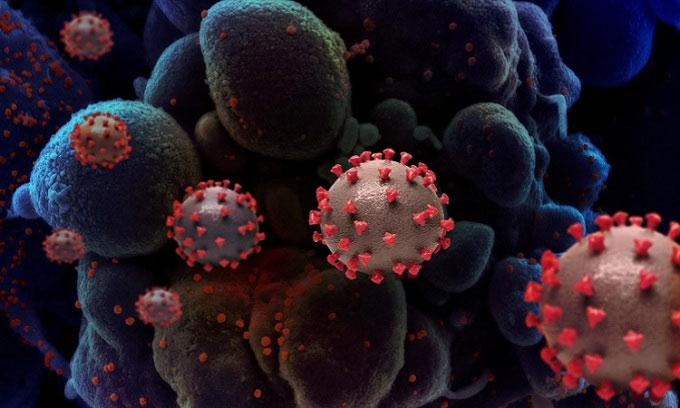OM-85, a cell lysate compound derived from bacteria, can prevent nCOV infections by reducing the virus’s ability to bind to the ACE2 receptor in the lungs.
A research team at the University of Arizona College of Medicine in Tucson found that combining bacterial extracts used in Europe for treating respiratory diseases could provide a new method to prevent or reduce nCoV infections. The study, published in the journal Allergy and Clinical Immunology on December 9, 2021, indicates that the bacterial extract mixture known as OM-85 prevents nCoV infections by decreasing the virus’s ability to attach to lung cells. OM-85 is a lysate, a molecular compound extracted from the cell walls of bacteria, commonly used to prevent upper respiratory infections in adults and children.

Simulation of nCoV attacking cells. (Photo: NIAID).
“Current infection prevention methods rely on vaccines to stimulate the immune system to respond by producing antibodies. Antibodies attach to a specific site (acting like a key) on the virus and prevent it from binding to the receptor (functioning like a lock) on the outside of lung cells. This study marks the first time scientists have targeted the receptor – the lock – using bacterial extracts and demonstrated the compound’s ability to block live virus. Essentially, we remove the lock from the cell wall so that the virus’s key has nowhere to fit,” explained Dr. Donata Vercelli, a professor of cellular and molecular medicine at the University of Arizona College of Medicine.
Upon entering the lungs, nCoV binds to the angiotensin-converting enzyme 2 (ACE2) receptor on the outer membrane of lung cells. A cellular enzyme alters the shape of the viral protein so that nCoV can penetrate the membrane and infect the cells. When the pandemic began, Vercelli and Vadim Pivniouk, an associate professor in the Department of Cellular and Molecular Medicine, along with several other team members, reviewed data they had collected in a study aimed at preventing asthma to check whether OM-85 had any effect on the ACE2 receptor.
Vercelli collaborated with Dr. Janko Nikolich-Žugich, a professor and chair of the Department of Immunology, and scientist Jennifer Uhrlaub. They found that OM-85 helps prevent nCoV infections by reducing the expression levels of the ACE2 receptor. “ACE2 is a key component,” Vercelli stated. “Without the initial binding, the entire infection process will be diverted and blocked.”
The mechanism by which OM-85 prevents viral infection differs from vaccines or antibody treatments, which focus on viral proteins. By targeting the receptor, OM-85 “locks” all doors for nCoV to enter cells. This could make OM-85 effective against any variant that infects cells through the ACE2 receptor.
“Our innate immune system has evolved under environmental pressures such as viruses, but modern lifestyles often do not provide opportunities to develop protective immunity,” Vercelli noted. “Our idea is to use bacterial lysate to guide the immune system in protecting humans against viruses, similar to how people who frequently interact with farm animals are protected against many types of bacteria and microorganisms.” According to Vercelli, using bacterial lysates like OM-85 could encourage stronger interactions between the immune system and microorganisms.


















































